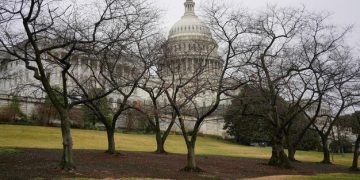Analyzing a 42% Presidential Approval Rating: What It Means for US Politics

What Does the Latest Presidential Approval Rating of 42% Reveal About Current Political Sentiment? A 42% approval rating suggests significant public skepticism, potentially signaling dissatisfaction with current policies, leadership, or broader socio-economic conditions, and influencing upcoming elections and policy debates.
A recent survey reveals a presidential approval rating of 42%. What Does the Latest Presidential Approval Rating of 42% Reveal About Current Political Sentiment? This figure offers a glimpse into the complex tapestry of public opinion and its potential impact on the political landscape. Let’s delve into the multiple layers of this number and discover what it tells us about the current state of affairs.
Understanding Presidential Approval Ratings
Presidential approval ratings are a cornerstone of political analysis. They act as a barometer, reflecting the public’s sentiment toward the president’s performance and policies. Understanding how these ratings are compiled and interpreted is crucial to gauging the political climate in the US.
Approval ratings aren’t just numbers; they are dynamic indicators influenced by a multitude of factors.
How Presidential Approval Ratings are Measured
Several polling organizations, such as Gallup, Pew Research Center, and Quinnipiac University, conduct surveys to determine presidential approval ratings. These surveys typically involve asking a representative sample of the US population whether they approve or disapprove of the president’s job performance.
Factors Influencing Approval Ratings
Approval ratings are influenced by a range of factors, including economic conditions, major policy decisions, and national events. For example, a strong economy often correlates with higher approval ratings, while controversial policy decisions can lead to a decline in approval. Major national events, such as natural disasters or international crises, can also significantly impact a president’s approval rating.
- Economic Conditions: A thriving economy generally boosts approval ratings.
- Policy Decisions: Popular policies can increase approval, while controversial ones can decrease it.
- National Events: Crises often lead to a temporary surge in approval, known as the “rally ‘round the flag” effect.
In conclusion, comprehending how presidential approval ratings are measured and the multifaceted factors that influence them is essential for decoding the political narrative and forecasting potential shifts in public sentiment.

The Significance of a 42% Approval Rating
A 42% approval rating is generally considered low for a US president. It suggests that a significant portion of the population is dissatisfied with the president’s performance. This level of disapproval can have far-reaching implications for the president’s ability to govern effectively.
This rating can be considered a turning point for current and future policies.
Historical Context of Similar Ratings
Historically, presidents with approval ratings around 42% have faced significant challenges. They often struggle to pass legislation, encounter resistance from their own party, and face increased scrutiny from the media. Examining past presidencies with similar ratings provides valuable insights into potential outcomes.
Potential Implications for the President’s Agenda
A low approval rating can weaken a president’s political capital. This can make it more difficult to garner support for their policy agenda, especially in a closely divided Congress. The president may need to make compromises or shift strategies to regain public trust and advance their goals.
- Legislative Challenges: Difficulty in passing key bills.
- Political Opposition: Increased resistance from opposing parties.
- Reduced Influence: Limited ability to shape public discourse.
In summary, a 42% approval rating indicates a precarious position for the president, potentially leading to legislative gridlock, increased political opposition, and a diminished ability to influence public opinion and policy outcomes.
Analyzing the Factors Behind the Current Rating
Several factors could contribute to a 42% presidential approval rating. These factors can range from specific policy decisions to broader economic and social trends. Understanding these underlying drivers is vital for a comprehensive analysis.
Breaking down these factors shows complex areas that needs to be addressed.
Recent Policy Controversies
Controversial policy decisions, such as changes to healthcare, immigration, or environmental regulations, can significantly impact approval ratings. Public perception of these policies often depends on how they are framed and the extent to which they affect different segments of the population.
Economic Indicators and Public Sentiment
Economic indicators, such as unemployment rates, inflation, and GDP growth, play a crucial role in shaping public sentiment. A struggling economy can lead to widespread dissatisfaction, while periods of economic prosperity tend to boost approval ratings. The public’s perception of economic stability directly influences their views on the president’s performance.
Social and Cultural Issues
사회적, 문화적 문제 Social and cultural issues, such as debates over social justice, identity politics, and cultural values, can also drive public sentiment and affect presidential approval ratings. The president’s stance on these issues can either rally support or alienate certain segments of the population, depending on their values and beliefs.
- Policy Perception: How the public views the impact of specific policies.
- Economic Stability: The influence of economic indicators on public sentiment.
- Cultural Alignment: How the president’s stance aligns with societal values.
In conclusion, analyzing the interplay of recent policy controversies, economic indicators, and social issues provides a nuanced understanding of the factors contributing to the current presidential approval rating, enabling a more informed assessment of the political landscape.

Impact on the Midterm Elections
Presidential approval ratings are often seen as a bellwether for midterm elections. Historically, low approval ratings have been associated with significant losses for the president’s party in Congress. Understanding this dynamic is crucial for predicting the outcome of upcoming elections.
This impact can dictate which policies are possible and can lead to leadership changes.
Historical Trends in Midterm Elections
Historically, the president’s party tends to lose seats in Congress during midterm elections, especially when the president has low approval ratings. This trend is driven by a combination of factors, including voter dissatisfaction, lower turnout among the president’s supporters, and increased mobilization by the opposition party.
Potential Scenarios Based on the Current Rating
Based on the current 42% approval rating, the president’s party could face significant losses in the upcoming midterm elections. However, the actual outcome will depend on various factors, including the quality of candidates, the effectiveness of campaign strategies, and any major events that occur between now and the election.
Strategies for Mitigating Losses
To mitigate potential losses, the president’s party may need to focus on mobilizing their base, highlighting their accomplishments, and differentiating themselves from the president’s policies. They may also need to address voter concerns about the economy and other key issues. Effective communication and targeted outreach can help shore up support and minimize losses.
- Historical Precedents: Understanding past midterm election outcomes.
- Predictive Factors: Identifying elements influencing election results.
- Mitigation Tactics: Strategies to counter potential losses.
In summary, the president’s approval rating substantially influences midterm election outcomes, with historical trends suggesting potential losses for the president’s party. Strategic efforts to mobilize voters, highlight accomplishments, and address key concerns are crucial for mitigating these losses.
The Role of Media and Public Perception
The media plays a significant role in shaping public perception of the president. How the media frames news stories and presents information can influence approval ratings. Understanding the media’s influence is essential for interpreting the current political landscape.
The media acts as the messenger for many of these policies.
Media Framing and its Influence
Media framing refers to how news organizations present and contextualize information. The way a story is framed can significantly influence public opinion. For example, a news story that emphasizes the negative consequences of a policy may lead to lower approval ratings, while a story that highlights the positive effects may boost approval.
The Impact of Social Media
Social media has become an increasingly important source of information and a powerful tool for shaping public opinion. The rapid spread of information and the ability for individuals to share their views can amplify certain narratives and influence approval ratings. Social media can also be used to mobilize support or opposition to the president.
Strategies for Shaping Public Perception
Presidents and their administrations often employ various strategies to shape public perception, including carefully crafting their messages, engaging with the media, and using social media to communicate directly with the public. Effective communication strategies can help influence public opinion and improve approval ratings. Transparency and consistency in messaging are also crucial for building trust.
- Framing Effects: How media portrayal impacts public opinion.
- Social Influence: The role of social media in shaping views.
- Communication Tactics: Strategies to manage public perception.
In conclusion, media framing and social media play pivotal roles in shaping public perception of the president. Strategic communication and proactive engagement are essential tools for influencing public opinion and maintaining or improving approval ratings.
Looking Ahead: What Can the President Do?
Given a 42% approval rating, there are several steps the president can take to improve their standing with the public. These steps may involve policy adjustments, communication strategies, and efforts to address key concerns.
Steps to take include listening to the people and adjusting the messages.
Policy Adjustments and Compromises
One strategy is to consider policy adjustments and compromises to address public concerns. This may involve modifying existing policies or working with the opposition party to find common ground on key issues. Demonstrating a willingness to compromise can help build goodwill and broaden support.
Improving Communication and Outreach
Improving communication and outreach is crucial for regaining public trust. This may involve more frequent communication with the public, greater transparency about policy decisions, and targeted outreach to specific groups. Effective communication can help clarify the president’s positions and address misconceptions.
Focusing on Bipartisan Issues
Focusing on bipartisan issues, such as infrastructure, job creation, or national security, can help the president build consensus and demonstrate their ability to work across the aisle. Addressing issues that have broad appeal can help improve approval ratings and create opportunities for progress.
- Adaptive Policies: Adjusting policies to meet public needs.
- Transparent Communication: Enhancing public understanding through clarity.
- Collaborative Agenda: Focusing on issues with bipartisan support.
In summary, the president can take several proactive steps to improve their public standing, including policy adjustments, enhanced communication, and a focus on bipartisan solutions, all aimed at regaining public trust and support.
| Key Point | Brief Description |
|---|---|
| 📊 Approval Rating | Reflects public sentiment toward the president’s performance. |
| 🏛️ Midterm Impact | Low ratings often lead to congressional losses for the president’s party. |
| 📰 Media’s Role | Shapes public opinion through framing and coverage. |
| 🔄 Policy Adjustments | Compromises can help improve public standing. |
Frequently Asked Questions
A presidential approval rating is a percentage that indicates the proportion of the public that approves of the president’s job performance at a specific point in time, commonly measured through polls and surveys.
These ratings offer key insights into public sentiment, influencing the president’s ability to govern, push policy agendas, and impacting the outcomes of midterm and presidential elections.
Economic conditions, significant policy decisions, national and international events, media coverage, and social and cultural issues all play a role in shaping approval ratings of a president.
A president can focus on addressing pressing public concerns, making policy adjustments, improving communication strategies, and working on bipartisan issues to regain the public’s trust.
Historically, low approval ratings of a president often lead to considerable losses for the president’s party in midterm elections, showing a direct correlation between presidential popularity and election outcomes.
Conclusion
Understanding a 42% presidential approval rating requires a nuanced analysis of numerous interconnected factors. By examining these elements, we gain a deeper insight into the political sentiment shaping the nation and the strategies presidents might adopt to navigate these challenging tides.





